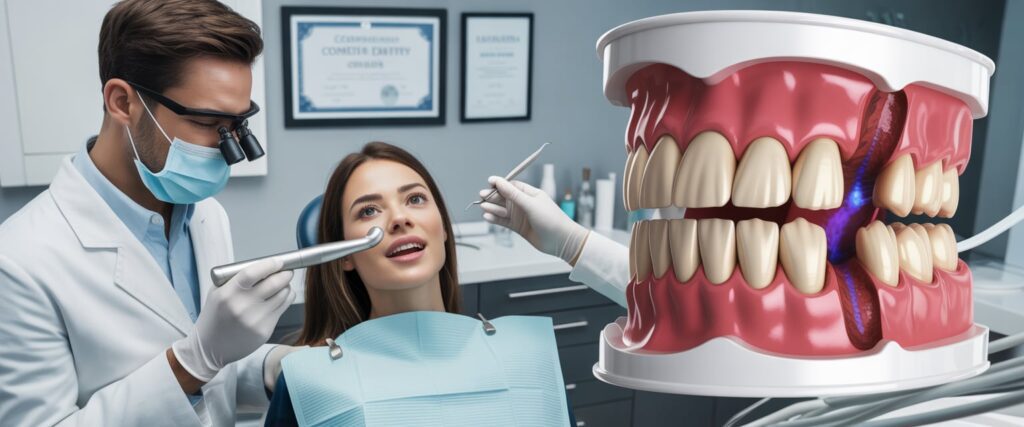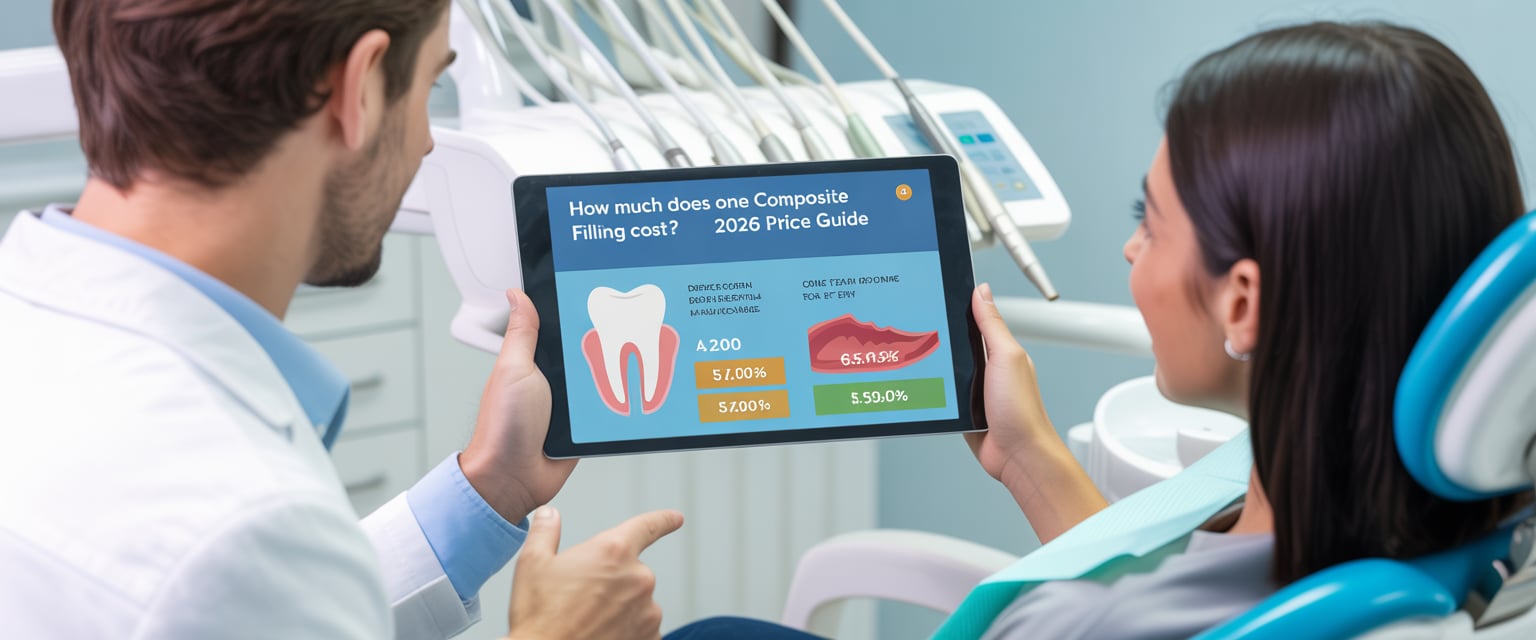Understanding dental expenses can feel overwhelming, especially with prices varying from country to country. If you’re asking yourself “How Much Does One Composite Filling Cost? 2026 Price Guide”, you’re already taking the right step toward making an informed dental care decision. Composite fillings have become the preferred option for millions of patients due to their natural appearance, durability, and ability to protect tooth structure.

However, costs differ significantly between the United States, Thailand, Türkiye, and India. This article answers the question “How Much Does One Composite Filling Cost? 2026 Price Guide” by breaking down global prices, insurance savings, and the key factors you need to consider before choosing the right treatment.
How Much Does One Composite Filling Cost?
Composite fillings, also called composite resin fillings, have become the most common choice for restoring teeth because they match natural tooth color and help maintain oral health without standing out. In 2026, the average cost of a composite filling ranges from about $90 to $250 per tooth in the United States, according to Happy Teeth Tips. In comparison, treatment costs often run lower in countries such as Thailand, Türkiye, and India, where quality dental care is more affordable.
He or she exploring dental treatment abroad might pay around $60 to $120 for a composite filling in Thailand, $70 to $150 in Türkiye, and roughly $40 to $100 in India. These wide price differences make dental tourism appealing for anyone searching for cost-effective tooth restoration options without sacrificing quality.

The cost of a composite dental filling depends on several factors, including the size of the cavity, location of the tooth, and whether dental insurance helps reduce the bill. Many plans cover about 50–80% of basic treatments, meaning a patient can save significantly on total out-of-pocket costs. For comparison, amalgam fillings are usually cheaper but less natural-looking, which often makes composite materials worth the investment for long-term oral health. To fully understand how much a cavity filling may cost, the article ahead breaks down real prices, insurance savings, and how to choose the best option.
Composite Filling Cost Breakdown: USA, Thailand, Türkiye, and India
Composite resin fillings are popular worldwide because they match natural teeth and preserve more tooth structure. Patients often compare the price of treatment across countries since the composite dental filling cost depends on labor rates, clinic setting, materials used, and insurance coverage.
Average Composite Filling Cost in the USA
In the United States, the composite filling cost varies based on the dentist’s location, the number of tooth surfaces, and whether dental insurance applies. A single composite resin filling typically costs $150–$450 per tooth, according to Dental Ecost Smile.
Urban areas tend to have higher rates due to rent and labor costs, with large cities averaging around $300 per filling. Smaller towns and rural areas may charge closer to $150.

With dental insurance, patients usually pay 20–50% out-of-pocket, reducing the composite filling cost with insurance to about $75–$225. Additional services, such as a dental exam or dental X-ray, can add $50–$200 to the total bill.
Composite Resin Fillings Cost in Thailand
Thailand offers significantly lower treatment prices while maintaining high-quality standards, especially in dental tourism hubs like Bangkok and Chiang Mai. On average, a composite dental filling costs $30–$80 per tooth, depending on the clinic’s reputation and location.
Clinics catering to international patients often include pre-treatment dental exams and digital X-rays in package prices, keeping the out-of-pocket cost predictable. Patients choosing large hospital-based clinics may pay closer to $100, while smaller offices are often more affordable.

Thailand’s cost advantage attracts many travelers seeking to combine dental care with tourism. The cost of composite fillings in Thailand is typically less than one-third of the average U.S. rate for similar materials and techniques.
Composite Filling Price in Türkiye
Türkiye (Turkey) has become one of the leading destinations for affordable dental restoration. For most patients, the composite filling cost ranges from $40–$120 per tooth, based on data from clinics serving both local and international patients. Major cities like Istanbul and Antalya have modern facilities offering competitive rates.
Professional experience and equipment quality explain cost differences between clinics. Including dental X-rays or consultation fees, total cavity filling cost often reaches $150 or less per visit.

Patients also favor Türkiye for quick appointment availability. The strong dental tourism market helps maintain fair prices while ensuring international care standards, making it a reliable choice for composite resin fillings abroad.
Cost of Composite Fillings in India
India provides some of the lowest composite filling prices in Asia while offering skilled dentists and updated dental clinics. Patients typically pay $25–$60 per tooth, depending on the city and the complexity of the cavity. In major metro areas like Delhi and Mumbai, the cost may approach $70, while smaller cities are even more economical.
Private dental hospitals often include a consultation and dental X-ray for a small additional fee, keeping total costs under $100. Insurance coverage for fillings is limited, so most patients pay out-of-pocket.

Low labor costs and locally produced materials allow clinics to offer safe, long-lasting composite resin fillings at a fraction of Western prices, making India an attractive destination for affordable dental restoration.
Composite Filling Cost Factors and Insurance Savings
Composite filling costs vary based on material type, dentist skill, procedure complexity, location, and insurance coverage. Patients can manage expenses through dental insurance, membership plans, or flexible financing like CareCredit.
Material Price Differences: Composite vs Amalgam and Others
Composite fillings typically cost more than amalgam fillings, but they offer a natural tooth-colored appearance and chemical bonding strength. In the United States, a composite dental filling usually ranges from $150 to $450 per tooth, while silver (amalgam) fillings average $50 to $200 per tooth. According to Dental ECost Smile, materials like ceramic and gold fillings can exceed $1,000 per tooth because they require more time and precision.

Material choice directly affects both longevity and appearance. While porcelain fillings resist stains and last longer, they can cost two to three times more than resin-based options. Gold fillings, though extremely durable, remain the most expensive and are less favored for visible teeth. For patients seeking affordability and function, amalgam remains practical, but composite materials offer stronger cosmetic value.
| Filling Type | Average Cost (USD) | Lifespan | Common Use |
|---|---|---|---|
| Amalgam (Silver) | $50–$200 | 10–15 years | Back teeth |
| Composite (Resin + Glass) | $150–$450 | 5–10 years | Front/visible teeth |
| Ceramic (Porcelain) | $250–$1,500 | 10–15 years | Cosmetic use |
| Gold | $500–$4,500 | 15–30 years | Molars |
Cost With Dental Insurance and Discount Plans
Most dental insurance plans cover 50–80% of composite filling costs after the deductible and copayment. The final cost depends on plan details and whether the dentist is in-network. As explained by Tooth Remedy, patients without coverage should expect to pay out of pocket unless they use dental discount plans or financing programs.

Discount networks like DentalPlans.com and flexible payment systems such as CareCredit can lower immediate expenses. Some HMO dental plans have lower premiums but fewer provider options, while PPO plans offer greater flexibility with slightly higher costs. Reviewing policy limits and material coverage helps patients avoid surprises since some insurers only reimburse for amalgam prices, even if a composite is used.
How Dental Procedure Complexity and Dentist Expertise Affect Price
More complex filling procedures take longer and often require additional materials or anesthesia, raising total cost. A small surface filling may cost under $200, but a large multi-surface restoration can exceed $450. Dentists with advanced training in cosmetic or restorative dentistry may charge more for precision work and enhanced shaping or shading.

Patients experiencing dental anxiety sometimes request sedation or numbing options that increase cost slightly. Clinics offering laser decay removal or digital cavity mapping may also have higher fees because of advanced equipment. Still, their expertise can reduce discomfort and improve long-term results. Skilled application helps the filling last longer and prevents future decay or cracking, saving money over time.
Location and Other Influences on Composite Filling Cost
Geographic location strongly impacts pricing. In the United States, composite fillings average $150–$450. In Thailand, they usually range from ฿1,800 to ฿4,500 (around $50–$125). In Türkiye, the typical cost is ₺1,500–₺3,500 (about $50–$115), and in India, costs range from ₹1,000 to ₹3,500 (roughly $12–$45).

Urban dental offices tend to charge more than clinics in smaller cities. Operating expenses, staff wages, and technology investment influence these variations. Local economic factors and access to imported materials also play roles. Comparing prices through clinic websites or free online estimates can help find affordable, high-quality care both domestically and abroad.
Conclusion
Choosing the right composite filling depends on your budget, dental needs, and whether you are open to exploring treatment options abroad. Throughout this article, we’ve addressed the essential question “How Much Does One Composite Filling Cost? 2026 Price Guide” by comparing prices across major dental tourism destinations and explaining how insurance and clinic quality influence final costs. As you evaluate your options, keep in mind that affordability doesn’t have to mean compromising on quality. With the insights provided in this “How Much Does One Composite Filling Cost? 2026 Price Guide”, you can confidently select a treatment plan that protects both your smile and your budget.
Frequently Asked Questions
Composite resin fillings vary in cost depending on country, insurance, and the dentist’s skill. Key price factors include tooth location, material quality, and clinic type, with costs often ranging from modest in parts of Asia to higher in the United States.
What is the average cost of a composite dental filling in the USA?
In the United States, a composite dental filling generally costs between $150 and $450 per tooth. Larger or more complex fillings can exceed that amount. According to Dental Ecost Smile, the price often depends on the type of tooth treated, with molars costing slightly more due to extra material and labor.
How much does a composite resin filling typically cost in Thailand?
In Thailand, the cost for a single composite resin filling usually falls between ฿800 and ฿2,500 (about $22–$68 USD). Prices in private clinics in Bangkok or tourist areas tend to be higher than those in smaller cities. Patients often choose Thailand for dental care because quality treatment remains affordable compared to Western countries.
What is the price range for composite fillings in Türkiye?
Türkiye’s composite fillings typically cost ₺1,200–₺3,000 per tooth, which equals roughly $35–$90 USD. Costs vary based on clinic reputation, dentist experience, and the size of the cavity. Treatment in Istanbul and major cities tends to cost more than in smaller towns offering dental tourism packages.
Can you breakdown the cost of composite resin fillings in India?
In India, a composite resin filling generally ranges from ₹800 to ₹2,500 (around $10–$30 USD). Urban clinics and cosmetic dentists charge the upper end of this range. Many patients choose composite fillings because they blend well with natural teeth and still remain far more affordable than in many other countries.
How does insurance impact the cost of composite fillings?
Insurance can reduce composite filling costs by 50–80%, depending on the plan’s terms. Most dental insurance policies cover basic restorative treatments but may require patients to pay more for cosmetic work. Those without insurance often face the full cost unless they use discount dental plans or payment programs offered by clinics.
What are the main factors that affect the price of composite dental fillings?
Composite filling prices depend on several factors—tooth size, cavity depth, dentist expertise, and clinic location. Urban practices generally charge more due to higher operating costs. As noted by Happy Teeth Tips, aesthetic demands and the number of surfaces treated also influence final pricing.
